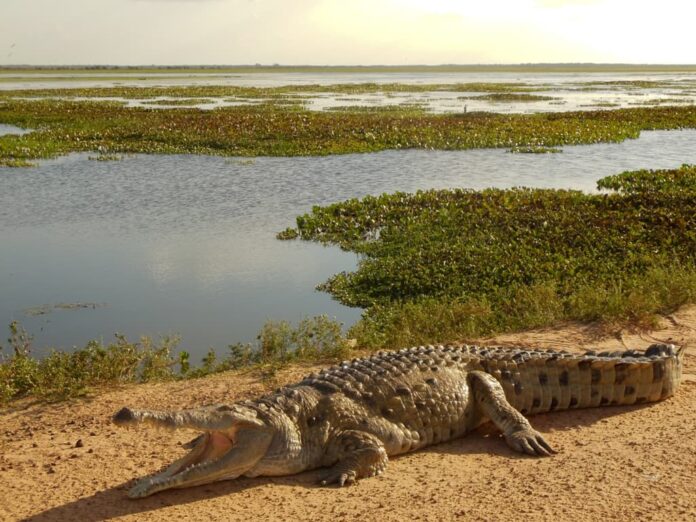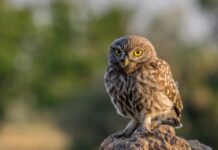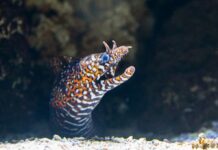Have you ever wondered what large freshwater crocodile species are out there? Well, I have found 5 of them, and they are from different parts of the world. The similarities that they share are their large size, their freshwater habitats, and their danger. Feel free to find out more about the large freshwater crocodile species below.
1American Crocodile
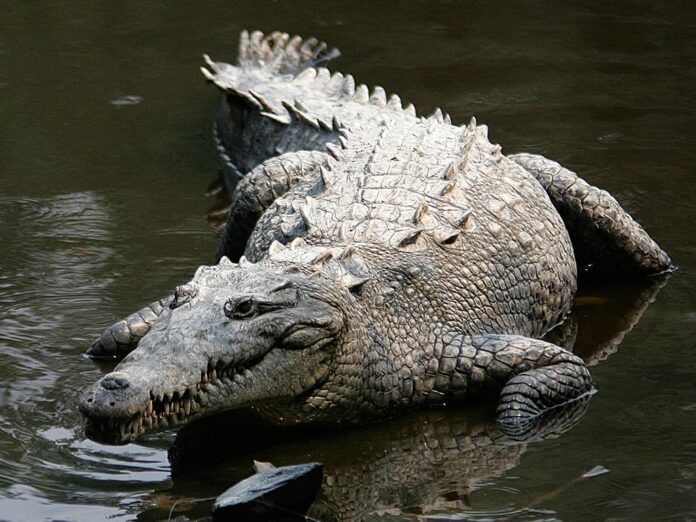
Scientific Name: Crocodylus Acutus
The American crocodile is one of the largest crocodile species, reaching more than 7 meters long. An American crocodile has a scaly hide on its body with rows of scutes running down its back and tail. It has short stocky legs, and a long and powerful tail that plays an important role in swimming. The body is grayish-green or olive-brown in adults, and juveniles are lighter tan with dark cross-banding on their tail and back. An American crocodile has sharp and jagged teeth that interlock with each other and are visible when its mouth is closed. Its ears, eyes, and nostrils are on top of its skull, allowing it to hear, see, and breathe while submerging underwater.
American crocodiles roam brackish and coastal areas, inhabiting brackish lakes, cays, lagoons, mangrove swamps, ponds, and small islands. However, they also go into river systems sometimes. It is very common to see them basking in the sun, with their mouths wide open. They use external sources of heat to regulate their body temperature. Being apex predators, their prey is pretty much anything, and they have no natural predators. When hunting, an American crocodile remains completely motionless in the water before grabbing and drowning the prey that comes close. It downs the prey with a maneuver, known as the “death roll”.
With their large size and sharp teeth, these crocodiles are obviously dangerous to be around, but they are less aggressive than other species. In fact, they are a reclusive and shy species, and they will quickly enter the water if a person approaches while they are basking. The American crocodiles are listed as Vulnerable on the IUCN Red List due to hide hunting, habitat loss, and pollution.
2Australian Freshwater Crocodile
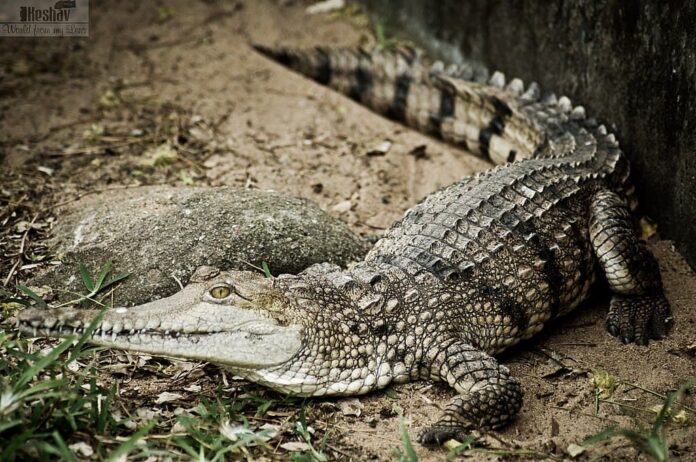
Scientific Name: Crocodylus Johnstoni
Australian freshwater crocodile aka the freshie, is a large freshwater crocodile species native to Australia. It can reach the length of 3 meters, and specimens of 4 meters have been recorded as well. A freshie is light brown in color, with darker bands on its body and tail. The tail is long and powerful, taking up almost half the total length of the animal. It has large body scales along with wide close-knit armor plates on its back. The snout is slender and small, with fine sharp teeth that are clearly visible when the mouth is closed. When moving overland, it performs a “high walk” whereby the body is held high so that it does not touch the ground. With longer hind legs, it can run at a speed of 17 kilometers per hour, making it among the fastest crocodiles on land.
The freshie occurs in the Northern Territory, Queensland, and Western Australia, inhabiting billabongs, creeks, freshwater wetlands, and rivers. Its diet consists of many things such as birds, crustaceans, fish, frogs, snakes, turtles, and various mammals like wallabies and more. These nocturnal hunters ambush prey in the water, and they also hunt on land as well. It is very normal for everything in Australia to want to kill you, but things are different with the freshie. It does bite in self-defense, but it does not go out of its way to attack people as potential prey. As a matter of fact, it is generally shy and quick to flee from human disturbance. Their current threats are climate change, habitat loss, and poisoning by cane toads.
3Nile Crocodile

Scientific Name: Crocodylus Niloticus
What we have here is the largest freshwater crocodiles in Africa, reaching the length of 5 meters. Actually, it is the second-largest extant reptile in the world, after the saltwater crocodile. It has a dark bronze body with faded blackish spots and stripes across the back. As for its flank, it is yellowish-green in color, with dark patches arranged in stripes and patterns. That body is adorned with a scale hide with rows of scutes running down its back and tail. Its legs are short and splayed, and it has a long and powerful tail. This large freshwater crocodile species has a powerful bite, and it has sharp conical teeth that deliver a strong grip. Once those teeth sink into a prey’s flesh, there is no letting go.
Nile crocodiles are native to freshwater habitats in Africa, with a wide distribution across 26 countries. These reptiles inhabit various habitats such as dams, estuaries, fast-flowing rivers, lakes, marshes, and swamps, and they can also enter coastal waters. It is also the largest predator in Africa, and these opportunistic apex predator is very aggressive. While some large freshwater crocodile species avoid humans, this one will attack. They are responsible for hundreds of human deaths every year. When it comes to food, the sky is the limit. These crocodiles can and will take on any animals, including birds, fish, mammals, and reptiles. As ambush predators, Nile crocodiles can wait for hours, days, or even weeks for prey. There are so many of them in the wild, and their population is doing more than great. However, they are still facing threats such as habitat loss, hunting, and pollution.
4Orinoco Crocodile
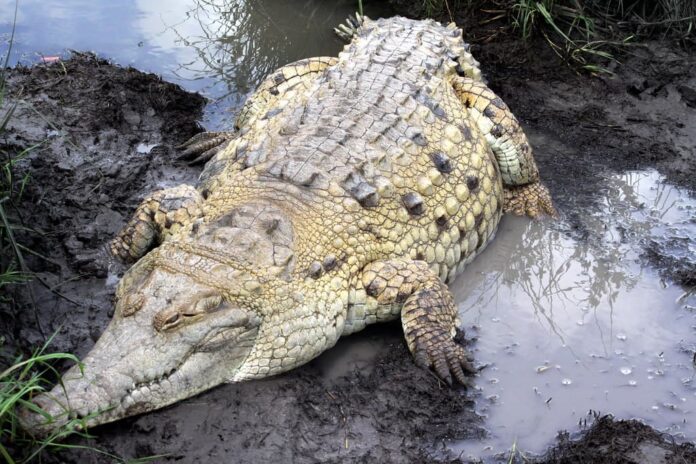
Scientific Name: Crocodylus Intermedius
This is another large freshwater crocodile species, growing up to over 5 meters long. An Orinoco crocodile has 3 different colorations in individuals: some are dark brownish-gray, some are pale tan, while some are yellowish. It also has dark brown markings scattered on its body, and there are scutes all over the body also. What’s super cool about them is that they can change the amount of melanin in their hide; hence the color variation. The distinctive feature of this crocodile is the arrangement of dorsal armor with 6 prominent scales on the back of its neck. Each scale has a rough texture, and they are different in color. This crocodile has a relatively long and narrow snout, equipped with sharp teeth.
Orinoco crocodiles live in the Meta River Basin in Colombia and the Orinoco River Basin in Venezuela. They inhabit various riparian habitats such as seasonal freshwater rivers, streams, tropical forests, and more. During the rainy season, they often leave the river and travel overland to nearby lakes and ponds. When the water recedes, they return to the river. It is also an apex predator that preys on birds, fish, invertebrates, mammals, and reptiles, as well as caiman. Despite that, they can go for weeks or months without food thanks to their super low metabolism.
Their population is not doing so well, and they are considered Critically Endangered due to a small population and other threats. Humans poached them for their hide, and recent threats are live animal trade, competition for food, nest poaching, and pollution. There are fewer than 150 mature individuals remaining in the wild now, and if they go extinct, it is because of humans.
5Siamese Crocodile

Scientific Name: Crocodylus Siamensis
A Siamese crocodile can grow up to 4 meters long, and it has an olive-green body. This coloration allows it to camouflage very well in the mossy waters in its habitats. Juveniles are golden tan with black stripes on their bodies and tail, and their bodies become darker as they mature. Its body scales are smaller and lack the bony bumps, which gives it a more uniform surface and smooth texture. The most distinctive feature of this large freshwater crocodile species is the prominent bony crests behind each eye. It has a broad and smooth snout, and there is a row of 4 large post-occipital scales on its neck.
Native to Southeast Asia, the Siamese crocodiles are found in Cambodia, Indonesia, Laos, Thailand, and Vietnam. They live in a wide variety of habitats such as lakes, marshes, seasonal oxbow lakes, slow-moving rivers and streams, and swamps. Adults mainly feed on fish and snakes, but they also take on amphibians and small mammals. Siamese crocodiles are not aggressive, and there have been very few reported attacks on humans in the past century.
Siamese crocodile has the biggest population in Cambodia, estimated between 200 to 400 individuals. In other countries, their population is facing threats from habitat degradation, habitat loss, human disturbance, and illegal capture. Humans poach them for the fine and soft leather that they produce. Their status on the IUCN Red List is now Critically Endangered.
Related Post: Large Caiman Species

